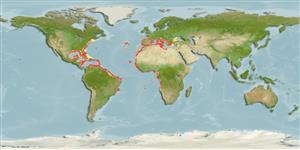Common names from other countries
Environment: milieu / climate zone / depth range / distribution range
Écologie
Benthopélagique; profondeur 20 - 828 m (Ref. 8), usually 100 - 400 m (Ref. 8). Subtropical; 8°C - 15°C (Ref. 804), preferred 24°C (Ref. 107945); 48°N - 19°S, 98°W - 37°E
Atlantic and the Mediterranean: from USA to French Guiana, the entire Mediterranean and from Portugal to Namibia.
Length at first maturity / Taille / Poids / Âge
Maturity: Lm 2.4, range 1 - 2.8 cm Max length : 16.0 cm TL mâle / non sexé; (Ref. 8); 19 cm TL (female); common length : 14.0 cm TL mâle / non sexé; (Ref. 8); common length :16 cm TL (female); âge max. reporté: 3.00 années (Ref. 80253)
Demersal (Ref. 85316). Maximum depth range from Ref. 114857; minimum common depth from Ref. 80253. Maximum total length (female) from Ref. 104052 Prefers mud or muddy sand substrates (Ref. 8). Juveniles settle at around 100 m, though can be detected up to 300 m, while larger individuals are always found deeper than 350 m (Ref. 80253). Feeds on benthic organisms (clams, mysids and small crangonids; Ref. 434). Also occurs in pelagic depths between 100 to 200 m (Ref. 92299). Opportunistic predator (Ref. 112170).
The species has a life cycle of 2 to 3 years (Ref. 80253). Mating behavior: Precopulatory courtship ritual is common (through olfactory and tactile cues); usually indirect sperm transfer (Ref. 833).
Holthuis, L.B. 1980. (Ref. 8)
Statut dans la liste rouge de l'IUCN (Ref. 130435)
statut CITES (Ref. 108899)
Not Evaluated
Not Evaluated
Utilisations par l'homme
Pêcheries: commercial
FAO - pêcheries: landings, species profile | FIRMS (Stock assessments) | FishSource | Sea Around Us
Outils
Sources Internet
Estimates based on models
Preferred temperature
(Ref.
115969): 9.4 - 19.5, mean 14 (based on 393 cells).
Résilience
Haut, temps minimum de doublement de population inférieur à 15 mois (K=0.44-2; tm=0.6; tmax=3).
Prior r = 1.40, 95% CL = 0.92 - 2.10, Based on 15 full stock assessments.
Vulnérabilité
Low vulnerability (10 of 100).
